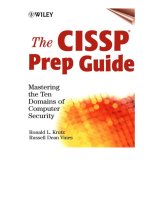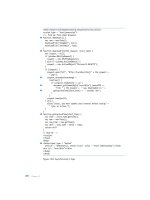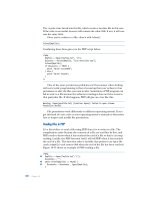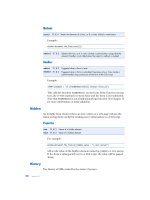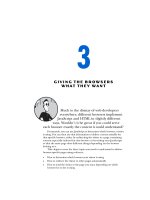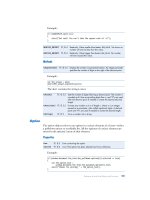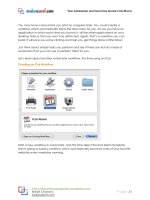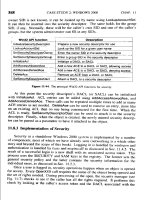The CISSP Prep Guide Gold Edition phần 10 ppsx
Bạn đang xem bản rút gọn của tài liệu. Xem và tải ngay bản đầy đủ của tài liệu tại đây (872.86 KB, 93 trang )
incorrect since the legislation reduces the ability of businesses to use
product price unfairly to persuade consumers to accept electronic
records. Answer d is incorrect since the legislation is specifically
technology-neutral to permit the use of the best technology for the
application.
13. Under Civil Law, the victim is NOT entitled to which of the following
types of damages?
a. Statutory
b. Punitive
c. Compensatory
d. Imprisonment of the offender
Answer: d
Imprisonment or probation is not a type of punishment available for
conviction of a civil crime. Answer a refers to awards set by law.
Answer b, punitive damages, are usually determined by the jury and
are intended to punish the offender. Compensatory awards are used to
provide restitution and compensate the victim for such items as costs
of investigations and attorneys’ fees.
14. Which of the following is NOT one of the European Union (EU) privacy
principles?
a. Individuals are entitled to receive a report on the information that is
held about them.
b. Data transmission of personal information to locations where
“equivalent” personal data protection cannot be assured is prohibited.
c. Information collected about an individual can be disclosed to other
organizations or individuals unless specifically prohibited by the
individual.
d. Individuals have the right to correct errors contained in their
personal data.
Answer: c
This principle is stated as an “opt-out” principle in which the
individual has to take action to prevent information from being
circulated to other organizations. The correct corresponding European
Union principle states that “information collected about an individual
cannot be disclosed to other organizations or individuals unless
authorized by law or by consent of the individual.” Thus, the
individual would have to take an active role or “opt-in” to authorize
the disclosure of information to other organizations. The other
principles are valid EU privacy principles.
Answers to Advanced Sample Questions 853
854 The CISSP Prep Guide: Gold Edition
15. Which of the following is NOT a goal of the Kennedy-Kassebaum
Health Insurance Portability and Accountability Act (HIPAA)
of 1996?
a. Provide for restricted access by the patient to personal healthcare
information
b. Administrative simplification
c. Enable the portability of health insurance
d. Establish strong penalties for healthcare fraud
Answer: a
HIPAA is designed to provide for greater access by the patient to
personal healthcare information. In answer b, administrative simpli-
fication, the goal is to improve the efficiency and effectiveness of the
healthcare system by:
■■
Standardizing the exchange of administrative and financial data
■■
Protecting the security and privacy of individually identifiable
health information
Answers c and d are self-explanatory.
16. The proposed HIPAA Security Rule mandates the protection of the
confidentiality, integrity, and availability of protected health
information (PHI) through three of the following activities. Which of the
activities is NOT included under the proposed HIPAA Security Rule?
a. Administrative procedures
b. Physical safeguards
c. Technical services and mechanisms
d. Appointment of a Privacy Officer
Answer: d
HIPAA separates the activities of Security and Privacy. HIPAA
Security is mandated under the main categories listed in answers a, b,
and c. The proposed HIPAA Security Rule mandates the appointment
of a Security Officer. The HIPAA Privacy Rule mandates the
appointment of a Privacy Officer. HIPAA Privacy covers individually
identifiable health care information transmitted, stored in electronic or
paper or oral form. PHI may not be disclosed except for the following
reasons:
■■
Disclosure is approved by the individual
■■
Permitted by the legislation
■■
For treatment
■■
Payment
■■
Health care operations
Answers to Advanced Sample Questions 855
■■
As required by law
Protected Health Information (PHI) is individually identifiable
health information that is:
■■
Transmitted by electronic media
■■
Maintained in any medium described in the definition of
electronic media …[under HIPAA]
■■
Transmitted or maintained in any other form or medium
17. Individual privacy rights as defined in the HIPAA Privacy Rule include
consent and authorization by the patient for the release of PHI. The
difference between consent and authorization as used in the Privacy Rule is:
a. Consent grants general permission to use or disclose PHI, and
authorization limits permission to the purposes and the parties
specified in the authorization.
b. Authorization grants general permission to use or disclose PHI, and
consent limits permission to the purposes and the parties specified
in the consent.
c. Consent grants general permission to use or disclose PHI, and
authorization limits permission to the purposes specified in the
authorization.
d. Consent grants general permission to use or disclose PHI, and
authorization limits permission to the parties specified in the
authorization.
Answer: a
Answer b is therefore incorrect. Answer c is incorrect since the
limits to authorization do not include the parties concerned. Answer
d is incorrect since the limits to authorization do not include the
specified purposes. The other individual privacy rights listed in the
HIPAA Privacy Rule are:
■■
Notice (of the covered entities’ privacy practices)
■■
Right to request restriction
■■
Right of access
■■
Right to amend
■■
Right to an accounting
In August of 2002, the U.S. Department of Health and Human
Services (HHS) modified the Privacy Rule to ease the requirements
of consent and allow the covered entities to use notice. The changes
are summarized as follows:
■■
Covered entities must provide patients with notice of the patient’s
privacy rights and the privacy practices of the covered entity.
856 The CISSP Prep Guide: Gold Edition
■■
Direct treatment providers must make a good faith effort to
obtain patient’s written acknowledgement of the notice of
privacy rights and practices. (The Rule does not prescribe a form
of written acknowledgement; the patient may sign a separate
sheet or initial a cover sheet of the notice.)
■■
Mandatory consent requirements are removed that would inhibit
patient access to health care while providing covered entities
with the option of developing a consent process that works for
that entity. If the provider cannot obtain a written
acknowledgement, it must document its good faith efforts to
obtain one and the reason for its inability to obtain the
acknowledgement.
■■
Consent requirements already in place may continue.
18. Because of the nature of information that is stored on the computer, the
investigation and prosecution of computer criminal cases have specific
characteristics, one of which is:
a. Investigators and prosecutors have a longer time frame for the
investigation.
b. The information is intangible.
c. The investigation does not usually interfere with the normal conduct
of the business of an organization.
d. Evidence is usually easy to gather.
Answer: b
The information is stored in memory on the computer and is
intangible as opposed to a physical object. Answer a is incorrect
since investigators and prosecutors are under time pressure to
gather evidence and proceed to prosecution. If the suspect is alerted,
he or she may do damage to the system or destroy important
evidence. Search warrants may have to be obtained by law
enforcement to search the suspect’s home and workplace and seize
computers and disks. Answer c is incorrect since an investigation
will interfere with the normal conduct of business. Some of the ways
in which an investigation may affect an organization are:
■■
The organization will have to provide experts to work with law
enforcement.
■■
Information key to the criminal investigation may be co-resident
on the same computer system as information critical to the day-
to-day operation of the organization.
■■
Proprietary data may be subject to disclosure.
Answers to Advanced Sample Questions 857
■■
Management may be exposed if they have not exercised “Due
Care” to protect information resources.
■■
There may be negative publicity that will be harmful to the
organization.
Answer d is incorrect. Evidence is difficult to gather since it is
intangible and easily subject to modification or destruction.
19. In order for evidence to be admissible in a court of law, it must be
relevant, legally permissible, reliable, properly identified, and properly
preserved. Reliability of evidence means that:
a. It must tend to prove a material fact; the evidence is related to the
crime in that it shows that the crime has been committed, can
provide information describing the crime, can provide information
as to the perpetrator’s motives, can verify what had occurred, and
so on.
b. The evidence is identified without changing or damaging the
evidence.
c. The evidence has not been tampered with or modified.
d. The evidence is not subject to damage or destruction.
Answer: c
This requirement is a critical issue with computer evidence since
computer data may be easily modified without having an indication
that a change has taken place. Answer a defines the relevancy of
evidence, answer b describes the identification of evidence, and
answer d describes the preservation of evidence.
20. In the U.S. Federal Rules of Evidence, Rule 803 (6) permits an exception
to the Hearsay Rule regarding business records and computer records.
Which one of the following is NOT a requirement for business or
computer records exception under Rule 803 (6)?
a. Made during the regular conduct of business and authenticated by
witnesses familiar with their use
b. Relied upon in the regular course of business
c. Made only by a person with knowledge of the records
d. Made by a person with information transmitted by a person with
knowledge
Answer: c
The business or computer records may be made by a person with
information transmitted by a person with knowledge, also. The
other answers are requirements for exceptions to the Hearsay Rule.
21. Law enforcement officials in the United States, up until passage of the
Patriot Act (see Question 9), had extensive restrictions on search and
seizure as established in the Fourth Amendment to the U.S. Constitution.
These restrictions are still, essentially, more severe than those on private
citizens, who are not agents of a government entity. Thus, internal
investigators in an organization or private investigators are not subject to
the same restrictions as government officials. Private individuals are not
normally held to the same standards regarding search and seizure since
they are not conducting an unconstitutional government search.
However, there are certain exceptions where the Fourth Amendment
applies to private citizens if they act as agents of the government/police.
Which of the following is NOT one of these exceptions?
a. The government is aware of the intent to search or is aware of a
search conducted by the private individual and does not object to
these actions.
b. The private individual performs the search to aid the government.
c. The private individual conducts a search that would require a search
warrant if conducted by a government entity.
d. The private individual conducts a warrantless search of company
property for the company.
Answer: d
Since the private individual, say an employee of the company,
conducts a search for evidence on property that is owned by the
company and is not acting as an agent of the government, a
warrantless search is permitted. The Fourth Amendment does not
apply. For review, the Fourth Amendment guarantees:
The right of the people to be secure in their persons, houses, papers,
and effects, against unreasonable searches and seizures, shall not be
violated, and no Warrants shall issue, but upon probable cause,
supported by oath or affirmation, and particularly describing the place
to be searched, and the persons or things to be seized.
The exigent circumstances doctrine provides an exception to these
guarantees if destruction of evidence is imminent. Then, a
warrantless search and seizure of evidence can be conducted if there
is probable cause to suspect criminal activity. Answers a, b, and c
describe exceptions where the private individual is subject to the
Fourth Amendment guarantees.
858 The CISSP Prep Guide: Gold Edition
22. One important tool of computer forensics is the disk image backup. The
disk image backup is:
a. Copying the system files
b. Conducting a bit-level copy, sector by sector
c. Copying the disk directory
d. Copying and authenticating the system files
Answer: b
Copying sector by sector at the bit level provides the capability to
examine slack space, undeleted clusters and possibly, deleted files.
With answer a, only the system files are copied and the other
information recovered in answer b would not be captured. Answer c
does not capture the data on the disk, and answer d has the same
problem as answer a. Actually, authenticating the system files is
another step in the computer forensics process wherein a message
digest is generated for all system directories and files to be able to
validate the integrity of the information at a later time. This
authentication should be conducted using a backup copy of the disk
and not the original to avoid modifying information on the original.
For review purposes, computer forensics is the collecting of information
from and about computer systems that is admissible in a court of law.
23. In the context of legal proceedings and trial practice, discovery refers to:
a. The process in which the prosecution presents information it has
uncovered to the defense, including potential witnesses, reports
resulting from the investigation, evidence, and so on
b. The process undertaken by the investigators to acquire evidence
needed for prosecution of a case
c. A step in the computer forensic process
d. The process of obtaining information on potential and existing
employees using background checks
Answer: a
The key words are legal proceedings and trial practice. Information
and property obtained in the investigation by law enforcement
officials must be turned over to the defense. For some information
that is proprietary to an organization, restrictions can be placed on
who has access to the data. Answers b, c, and d are forms of the
investigative process. During an investigation, answers b and c are
appropriate definitions of discovery.
Answers to Advanced Sample Questions 859
860 The CISSP Prep Guide: Gold Edition
24. Which of the following alternatives should NOT be used by law
enforcement to gain access to a password?
a. Using password “cracker” software
b. Compelling the suspect to provide the password
c. Contacting the developer of the software for information to gain
access to the computer or network through a back door
d. Data manipulation and trial procedures applied to the original ver-
sion of the system hard disk
Answer: d
The original disk of a computer involved in a criminal investiga-
tion should not be used for any experimental purposes since data
may be modified or destroyed. Any operations should be conducted
on a copy of the system disk. However, the answers in a, b, and c are
the preferred methods of gaining access to a password-protected sys-
tem. Interestingly, in answer b, there is legal precedent to order a sus-
pect to provide the password of a computer that is in the custody of
law enforcement.
25. During the investigation of a computer crime, audit trails can be very
useful. To ensure that the audit information can be used as evidence,
certain procedures must be followed. Which of the following is NOT
one of these procedures?
a. The audit trail information must be used during the normal course
of business.
b. There must be a valid organizational security policy in place and in
use that defines the use of the audit information.
c. Mechanisms should be in place to protect the integrity of the audit
trail information.
d. Audit trails should be viewed prior to the image backup.
Answer: d
The image backup should be done first in order not to modify any
information on the hard disk. For example, the authentication
process applied to a hard disk can change the time of last access
information on files. Thus, authentication should be applied to a disk
image copy.
26. The Internet Activities Board (IAB) considers which of the following
behaviors relative to the Internet as unethical?
a. Negligence in the conduct of Internet experiments
b. Recordkeeping whose very existence is secret
Answers to Advanced Sample Questions 861
c. Recordkeeping in which an individual cannot find out what
information concerning that individual is in the record
d. Improper dissemination and use of identifiable personal data
Answer: a
The IAB document, Ethics and the Internet (RFC 1087) listed behav-
iors as unethical that:
■■
Seek to gain unauthorized access to the resources of the Internet
■■
Destroy the integrity of computer-based information
■■
Disrupt the intended use of the Internet
■■
Waste resources such as people, capacity and computers through
such actions
■■
Compromise the privacy of users
■■
Involve negligence in the conduct of Internetwide experiments
Answers b, c, and d are taken from the Code of Fair Information
Practices of the U.S. Department of Health, Education of Welfare.
27. Which of the following is NOT a form of computer/network
surveillance?
a. Keyboard monitoring
b. Use of network sniffers
c. Use of CCTV cameras
d. Review of audit logs
Answer: c
CCTV cameras fall under the category of physical surveillance.
Answers a and b are forms of active surveillance. These types of sur-
veillance require an organizational policy informing the employees that
the surveillance is being conducted. Additionally, warning banners
describing the surveillance at log-on to a computer or network should
be prominently displayed. These banners usually state that by logging
on, the user acknowledges the warning and agrees to the monitoring.
Answer d is a passive form of computer/network surveillance.
28. Which of the following is NOT a definition or characteristic of “Due
Care?”
a. Just, proper, and sufficient care, so far as the circumstances
demand it.
b. That care which an ordinary prudent person would have exercised
under the same or similar circumstances.
862 The CISSP Prep Guide: Gold Edition
c. Implies that a party has been guilty of a violation of the law in
relation to the subject-matter or transaction.
d. It may and often does require extraordinary care.
Answer: c
Due Care implies that not only has a party not been negligent or
careless, but also that he/she has been guilty of no violation of law
in relation to the subject mater or transaction which constitutes the
cause of action. “Due Care” and “Reasonable Care” are used
interchangeably. The definitions of Due Care given in answers a, b,
and c are from Black’s Law Dictionary, Abridged Fifth Edition, West
Publishing Company, St. Paul Minnesota, 1983.
29. The definition “A mark used in the sale or advertising of services to
identify the services of one person and distinguish them from the
services of others” refers to a:
a. Trademark
b. Service mark
c. Trade name
d. Copyright
Answer: b
For answer a, a trademark is a “distinctive mark of authenticity,
through which the products of particular manufacturers or the
vendible commodities of particular merchants may be distinguished
from those of others.” Answer c, a trade name is “any designation
which is adopted and used by a person to denominate goods which
he markets, or services which he renders or business which he
conducts. A trade name is descriptive of a manufacturer or dealer
and applies to business and goodwill. A trademark is applicable
only to vendible commodities. In answer d, a copyright is “an
intangible, incorporeal right granted by statute to the author or
originator of certain literary or artistic productions, whereby he is
invested, for a statutorily prescribed period, with the sole and
exclusive privilege of multiplying copies of the same and publishing
and selling them. (These definitions were also taken from Black’s
Law Dictionary, Abridged Fifth Edition, West Publishing Company,
St. Paul Minnesota, 1983.)
30. It is estimated that the Asia/Pacific region accounts for about $4 billion
worth of loss of income to software publishers due to software piracy.
Answers to Advanced Sample Questions 863
As with the Internet, cross-jurisdictional law enforcement issues make
investigating and prosecuting such crime difficult. Which of the
following items is NOT an issue in stopping overseas software piracy?
a. Obtaining the cooperation of foreign law enforcement agencies and
foreign governments.
b. The quality of the illegal copies of the software is improving,
making it more difficult for purchasers to differentiate between legal
and illegal products.
c. The producers of the illegal copies of software are dealing in larger
and larger quantities, resulting in faster deliveries of illicit software.
d. Lack of a central, nongovernmental organization to address the
issue of software piracy.
Answer: d
The Business Software Alliance (BSA) is a nongovernmental anti-
software piracy organization (www.bsa.org). The mission statement
of the BSA is:
The Business Software Alliance is an international organization rep-
resenting leading software and e-commerce developers in 65 coun-
tries around the world. Established in 1988, BSA has offices in the
United States, Europe, and Asia . . . . Our efforts include educating
computer users about software copyrights; advocating public policy
that fosters innovation and expands trade opportunities; and fighting
software piracy.
864 The CISSP Prep Guide: Gold Edition
Chapter 10—Physical Security
1. Which choice below is NOT a common biometric method?
a. Retina pattern devices
b. Fingerprint devices
c. Handprint devices
d. Phrenologic devices
Answer: d
Biometrics are commonly used to verify the authenticity of someone
attempting to gain access to a secure facility. Biometrics examine each per-
son’s unique physiological characteristics to provide positive personal
identification. Fingerprints and handwritten signatures have been used in
the past for identification, but modern biometric devices use many other
physical traits to allow entrance to a facility or access to a system. Several
types of biometric devices are common, such as retina pattern devices, fin-
gerprint devices, handprint devices, and voice pattern devices. The effec-
tiveness of these procedures and the impact of false positive and false
negative error rates is covered in the Access Control domain.
Phrenology was a pseudo-science developed in the late 18th cen-
tury to assign behavior attributes based upon the examination, the
shape, and unevenness of a head or skull. It was believed that one
could discover the development of the particular cerebral “organs”
responsible for different intellectual aptitudes and character traits.
For example, a prominent protuberance in the forehead at the posi-
tion attributed to the organ of “benevolence” was meant to indicate
that the individual had a “well developed” organ of benevolence and
would therefore be expected to exhibit benevolent behavior. It was
thought this could predict criminal or anti-social behavior. Source:
Computer Security Basics by Deborah Russell and G.T. Gangemi Sr.
(O’Reilly, 1992) and John van Wyhe, The History of Phrenology on the
Web ( February 8, 2002.
2. According to the NFPA, which choice below is NOT a recommended
risk factor to consider when determining the need for protecting the
computing environment from fire?
a. Life safety aspects of the computing function or process
b. Fire threat of the installation to occupants or exposed property
c. Distance of the computing facility from a fire station
d. Economic loss of the equipment’s value
Answer: c
Answers to Advanced Sample Questions 865
While the distance of the computing facility from a fire station
should be considered when initially determining the physical loca-
tion of a computing facility (as should police and hospital proximity),
it is not considered a primary factor in determining the need for
internal fire suppression systems. The National Fire Protection Asso-
ciation (NFPA) defines risk factors to consider when designing fire
and safety protection for computing environments. The factors to be
used when assessing the impact of damage and interruption result-
ing from a fire, in priority order, are:
■■
The life safety aspects of the function, such as air traffic controls
or safety processing controls
■■
The fire threat of the installation to the occupants or property of
the computing area
■■
The economic loss incurred from the loss of computing function
or loss of stored records
■■
The economic loss incurred from the loss of the value of the
equipment
As in all evaluations of risk, not only fire risk, life safety is always
the number one priority. Source: “NFPA 75 Standard for the Protec-
tion of Electronic Computer/Data Processing Equipment” National
Fire Protection Association, 1999 Edition.
3. Which choice below is NOT an example of a Halocarbon Agent?
a. HFC-23
b. FC-3-1-10
c. IG-541
d. HCFC-22
Answer: c
IG-541 is an inert gas agent, not a halocarbon agent. Halocarbon
agents or inert gas agents can be replacements for Halon 1301 and
Halon 1211 in gas-discharge fire extinguishing systems. Halocarbon
agents contain one or more organic compounds as primary
components, such as the elements fluorine, chlorine, bromine, or
iodine. Inert gas agents contain as primary components one or more
of the gases helium, neon, argon, or nitrogen. Some inert gas agents
also contain carbon dioxide as a secondary component. Halocarbon
agents are hydrofluorocarbons (HFCs), hydrochloroflurocarbons
(HCFCs), perfluorocarbons (PFCs or FCs), or fluoroiodocarbons
(FICs). Common inert gas agents for fire extinguishing systems are
IG-01, IG-100, IG -55, and IG-541. Source: “NFPA 2001 Standard on
866 The CISSP Prep Guide: Gold Edition
Clean Agent Fire Extinguishing Systems” National Fire Protection
Association, 2000 Edition.
4. Which choice below is NOT an example of a combustible in a Class B
fire?
a. Grease
b. Rubber
c. Oil-base paints
d. Flammable gases
Answer: b
Fire combustibles are rated as either Class A, B, C, or D based
upon their material composition, and this determines which type of
extinguishing system or agent is used. Rubber is considered an
ordinary Class A combustible. Table A.14 shows the different
combustibles and their related classes. Source: “NFPA 2001 Standard
on Clean Agent Fire Extinguishing Systems” National Fire
Protection Association, 2000 Edition.
5. Which statement below most accurately describes a “dry pipe”
sprinkler system?
a. Dry pipe is the most commonly used sprinkler system.
b. Dry pipe contains air pressure.
c. Dry pipe sounds an alarm and delays water release.
d. Dry pipe may contain carbon dioxide.
Answer: b
In a dry pipe system, air pressure is maintained until the sprinkler
head seal is ruptured. The air then escapes, and the water is brought
into the room. One advantage of the dry pipe system is that the wet
Table A.14 Combustible Materials Fire Class Ratings
FIRE CLASS COMBUSTIBLE MATERIALS
A Wood, cloth, paper, rubber, most plastics, ordinary
combustibles
B Flammable liquids and gases, oils, greases, tars, oil-base
paints and lacquers
C Energized electrical equipment
D Flammable chemicals such as magnesium and sodium
Answers to Advanced Sample Questions 867
pipe system is vulnerable to broken pipes due to freezing. Answer a is
incorrect; wet pipe is the most commonly used sprinkler system, dry
pipe is second. In a wet pipe system, water is standing in the pipe and is
released when heat breaks the sprinkler head seal. Answer c describes a
preaction pipe, which sounds an alarm and delays the water release.
This allows computer operations to shut down before the release of
water. A preaction pipe may or may not be a dry pipe, but not all dry
pipes are preaction. Answer d is incorrect, because a dry pipe is a water
release system. Source: “NFPA 75 Standard for the Protection of Elec-
tronic Computer/Data Processing Equipment” National Fire Protection
Association, 1999 Edition and “NFPA 13 Standard for the Installation of
Sprinkler Systems.”
6. Which choice below is NOT a recommendation for records and
materials storage in the computer room, for fire safety?
a. Green bar printing paper for printers should be stored in the
computer room.
b. Abandoned cables shall not be allowed to accumulate.
c. Space beneath the raised floor shall not be used for storage purposes.
d. Only minimum records required for essential and efficient operation.
Answer: a
The NFPA recommends that only the absolute minimum essen-
tial records, paper stock, inks, unused recording media, or other
combustibles be housed in the computer room. Because of the
threat of fire, these combustibles should not be stored in the com-
puter room or under raised flooring, including old, unused
cabling. Underfloor abandoned cables can interfere with airflow
and extinguishing systems. Cables that are not intended to be used
should be removed from the room. It also recommends that tape
libraries and record storage rooms be protected by an extinguish-
ing system and separated from the computer room by wall con-
struction fire-resistant rated for not less than one hour. Source:
“NFPA 75 Standard for the Protection of Electronic Computer/
Data Processing Equipment” National Fire Protection Association,
1999 Edition.
7. Which choice below is NOT considered an element of two-factor
authentication?
a. Something you know
b. Something you do
868 The CISSP Prep Guide: Gold Edition
c. Something you have
d. Something you are
Answer: b
Something you do, is an element of role-based access authentica-
tion, but is not an element of two-factor authentication. The most
common implementation of two-factor authentication are “smart
cards.” Some smart cards employ two-factor authentication
because they are an example of “something you have,” the
encoded card, with “something you know,” like a PIN or pass-
word. “Something you are” describes biometric authentication.
Source: Computer Security Basics by Deborah Russell and G.T.
Gangemi Sr. (O’Reilly, 1992).
8. Which choice below is NOT an example of a “clean” fire extinguishing
agent?
a. CO
2
b. IG-55
c. IG-01
d. HCFC-22
Answer: a
Since Halon was banned for use in fire suppression systems, many
different chemical agents have been used. Some of these agents are
called “clean” agents, because they do not leave a residue on elec-
tronic parts after evaporation. CO
2
, carbon dioxide, does leave a cor-
rosive residue, and is therefore not recommended for computer
facility fire suppression systems. A “clean agent” is defined as an
electrically nonconducting, nonvolatile fire extinguishant that does
not leave a residue upon evaporation. Answers b and c, IG-55, and
IG-01, are inert gas agents that do not decompose measurably or
leave corrosive decomposition products and are, therefore, consid-
ered clean agents. Answer d, HCFC-22, is a halocarbon agent, which
also is considered a clean agent. Source: “NFPA 2001 Standard on
Clean Agent Fire Extinguishing Systems” National Fire Protection
Association, 2000 Edition.
9. Which choice below is NOT considered a requirement to install an
automatic sprinkler system?
a. The building is required to be sprinklered.
b. The computer room is vented to outside offices.
Answers to Advanced Sample Questions 869
c. The computer room contains a significant quantity of combustible
materials.
d. A computer system’s enclosure contains combustible materials.
Answer: b
Computer room venting is an element of smoke detection and
protection. The room should not be vented to the outside unless
damping elements are installed to prevent smoke from the computer
room from entering other offices. An automatic sprinkler system
must be provided to protect the computer room or computer areas
when either:
■■
The enclosure of a computer system is built entirely or in part of
a significant quantity of combustible materials.
■■
The operation of the computer room or area involves a significant
quantity of combustible materials.
■■
The building is otherwise required to be sprinklered.
Source: “NFPA 75 Standard for the Protection of Electronic
Computer/Data Processing Equipment” National Fire Protection
Association, 1999 Edition and “NFPA 13 Standard for the
Installation of Sprinkler Systems.”
10. Which choice below is NOT a type of motion-detection system?
a. Ultrasonic-detection system
b. Microwave-detection system
c. Host-based intrusion-detection system
d. Sonic-detection system
Answer: c
Host-based intrusion-detection systems are used to detect
unauthorized logical access to network resources, not the physical
presence of an intruder. There are four basic technologies for
detecting the physical presence of an intruder:
■■
Photometric systems, which detect changes in the level of light
■■
Motion-detection systems, which detect Doppler-type changes in
the frequency of energy waves
■■
Acoustical seismic-detection systems, which detect changes in
the ambient noise level or vibrations
■■
Proximity-detection systems, which detect the approach of an
individual into an electrical field
Of the motion detection types, three kinds exist: sonic, ultrasonic,
and microwave, depending upon the wavelength of the transmitters
and receivers. Motion detectors sense the motion of a body by the
change in frequency from the source transmission. Sonic detection sys-
tems operate in the audible range, ultrasonic detection systems operate
in the high frequency, and microwave detection systems utilize radio
frequencies. Table A.15 shows the common frequencies of motion
detectors. Source: CISSP Examination Textbooks, Volume one: Theory by S.
Rao Vallabhaneni (SRV Professional Publications, first edition 2000).
11. Which fire extinguishant choice below does NOT create toxic HF levels?
a. Halon 1301
b. Halon 1211
c. IG-01
d. HCFC-22
Answer: c
HF stands for Hydrogen fluoride, a toxic by-product of hydrocarbon
agents after discharge. Answer c, IG-01, is an inert gas, which doesn’t
contain HFs. Inert gas does, however, create a danger to personnel by
removing most of the breathable oxygen in a room when flooded, and
precautions must be taken before its use. The inert gas agent IG-541
contains CO2 as an additive, which appears to allow for more breath-
able time in the computer facility to allow for evacuation, however
CO2 lessens the agent’s use as a “clean” agent. CO2 and Halon are
both toxic. Source: “NFPA 2001 Standard on Clean Agent Fire Extin-
guishing Systems” National Fire Protection Association, 2000 Edition.
12. Which choice below is NOT permitted under computer room raised
flooring?
a. Interconnecting DP cables enclosed in a raceway
b. Underfloor ventilation for the computer room only
c. Nonabrasive openings for cables
d. Underfloor ventilation to the rest of the offices’ ventilation system
Answer: d
Underfloor ventilation, as is true of all computer room ventilation,
should not vent to any other office or area. HVAC air ducts serving
870 The CISSP Prep Guide: Gold Edition
Table A.15 Common Motion Detection System Frequencies
DETECTOR TYPE FREQUENCY
Sonic 1500-2000 hertz
Ultrasonic 19,000-20,000 hertz
Microwave 400-10,000 megahertz
other rooms should not pass through the computer room unless an
automatic damping system is provided. A damper is activated by
fire and smoke detectors and prevents the spread of computer room
smoke or toxins through the building HVAC. Raised flooring, also
called a false floor or a secondary floor, has very strict requirements
as to its construction and use. Electrical cables must be enclosed in
metal conduit, and data cables must be enclosed in raceways, with
all abandoned cable removed. Openings in the raised floor must be
smooth and nonabrasive, and should be protected to minimize the
entrance of debris or other combustibles. Obviously, the raised
flooring and decking must be constructed from noncombustible
materials. Source: “NFPA 75 Standard for the Protection of
Electronic Computer/Data Processing Equipment” National Fire
Protection Association, 1999 Edition.
13. Which choice below represents the BEST reason to control the humidity
in computer operations areas?
a. Computer operators do not perform at their peak if the humidity is
too high.
b. Electrostatic discharges can harm electronic equipment.
c. Static electricity destroys the electrical efficiency of the circuits.
d. If the air is too dry, electroplating of conductors may occur.
Answer: b
Electrostatic discharges from static electricity can damage sensitive
electronic equipment, even in small amounts. Even though a static
charge of several thousand volts may be too low to harm humans,
computer equipment is sensitive to static charges. Dry air, below 40
percent relative humidity, increases the chance of static electricity
being generated. When the relative humidity is too high, say more
than 80 percent, electrical connections become inefficient. The electri-
cal contacts start to corrode and a form of electroplating begins. The
recommended optimal relative humidity level is 40 percent to 60 per-
cent for computer operations. Source: The International Handbook of
Computer Security by Jae K. Shim, Anique A. Qureshi, and Joel G.
Siegel (The Glenlake Publishing Co. Ltd, 2000).
14. Which statement below is NOT accurate about smoke damage to
electronic equipment?
a. Smoke exposure during a fire for a relatively short period does little
immediate damage.
b. Continuing power to the smoke-exposed equipment can increase the
damage.
Answers to Advanced Sample Questions 871
c. Moisture and oxygen corrosion constitute the main damage to the
equipment.
d. The primary damage done by smoke exposure is immediate.
Answer: d
Immediate smoke exposure to electronic equipment does little dam-
age. However, the particulate residue left after the smoke has dissipated
contains active by-products that corrode metal contact surfaces in the
presence of moisture and oxygen. Removal of the contaminant from the
electrical contacts, such as printed circuits boards and backplanes, should
be implemented as soon as possible, as much of the damage is done dur-
ing this corrosion period. Also, power should be immediately discon-
nected to the affected equipment, as continuing voltage can plate the
contaminants into the circuitry permanently. Source: “NFPA 75 Standard
for the Protection of Electronic Computer/Data Processing Equipment”
National Fire Protection Association, 1999 edition and “NFPA 2001 Stan-
dard on Clean Agent Fire Extinguishing Systems” 2000 edition.
15. Which choice below most accurately describes the prime benefit of
using guards?
a. Human guards are less expensive than guard dogs.
b. Guards can exercise discretionary judgment in a way that
automated systems can’t.
c. Automated systems have a greater reliability rate than guards.
d. Guard dogs cannot discern an intruder’s intent.
Answer: b
The prime advantage to using human guards is that they can exercise
discretionary judgment when the need arises. For example, during an
emergency guards can switch roles from access control to evacuation
support, something guard dogs or automated systems cannot. While
guard dogs are relatively expensive to keep, guards are generally the
most expensive option for access control. Answers c and d are dis-
tracters. An issue with guards, however, is that they can be socially engi-
neered, and must be thoroughly vetted and trained. Source: The NCSA
Guide to Enterprise Security by Michel E. Kabay (McGraw-Hill, 1996).
16. Which choice below is an accurate statement about EMI and RFI?
a. EMI can contain RFI.
b. EMI is generated naturally; RFI is man-made.
c. RFI is generated naturally; EMI is man-made.
d. Natural sources of EMI pose the greatest threat to electronic
equipment.
872 The CISSP Prep Guide: Gold Edition
Answers to Advanced Sample Questions 873
Answer: a
Electromagnetic interference (EMI) and radio-frequency interfer-
ence (RFI) are terms used to describe disruption or noise generated by
electromagnetic waves. RFI refers to noise generated from radio
waves, and EMI is the general term for all electromagnetic interference,
including radio waves. EMI and RFI are often generated naturally, for
example solar sunspots or the earth’s magnetic field. Man-made
sources of EMI and RFI pose the largest threat to electronic equipment
from sources like cell phones, laptops, and other computers. Guide-
lines to prevent EMI and RFI interference in the computer room should
be adopted, such as limiting the use and placement of magnets or cell
phones around sensitive equipment. The United States government
created the TEMPEST (Transient ElectroMagnetic Pulse Emanations
Standard) standard to prevent EMI eavesdropping by employing
heavy metal shielding. Source: The NCSA Guide to Enterprise Security by
Michel E. Kabay (McGraw-Hill, 1996).
17. In which proper order should the steps below be taken after electronic
equipment or media has been exposed to water?
_____ a. Place all affected equipment or media in an air-conditioned
area, if portable.
––––– b. Turn off all electrical power to the equipment.
––––– c. Open cabinet doors and remove panels and covers to allow
water to run out.
_____ d. Wipe with alcohol or Freon-alcohol solutions or spray with
water-displacement aerosol sprays.
Answer: b, c, a, and d.
Water-based emergencies could include pipe breakage, or damage
to sensitive electronic equipment due to the proper use of water fire
sprinklers. The first order of business is shutting down the power to
the effected equipment, to prevent shock hazards, shorting, or fur-
ther damage. Any visible standing water should be removed and
allowed to drain from around and the inside the unit. As the room
may still be extremely humid, move the equipment, if possible, to a
humidity-controlled environment, then wipe the parts and use water
displacement sprays. If corrective action is initiated immediately, the
damage done to the computer equipment can be greatly reduced and
the chances of recovering the data are increased. Source: “NFPA 75
Standard for the Protection of Electronic Computer/Data Processing
Equipment” National Fire Protection Association, 1999 Edition and
“Electronics and Magnetic Media Recovery” Blackmon-Mooring-
Steamatic Catastrophe Inc.
874 The CISSP Prep Guide: Gold Edition
18. Which choice below is NOT an example of using a social engineering
technique to gain physical access to a secure facility?
a. Asserting authority or pulling rank
b. Intimidating or threatening
c. Praising or flattering
d. Employing the salami fraud
Answer: d
The “salami fraud” is an automated fraud technique. In the salami
fraud, a programmer will create or alter a program to move small
amounts of money into his personal bank account. The amounts are
intended to be so small as to be unnoticed, such as rounding in foreign
currency exchange transactions. Hence the reference to slicing a salami.
The other three choices are common techniques used by an
intruder to gain either physical access or system access:
Asserting authority or pulling rank. Professing to have the
authority, perhaps supported with altered identification, to
enter the facility or system.
Intimidating or threatening. Browbeating the access control
subjects with harsh language or threatening behavior to permit
access or release information.
Praising, flattering, or sympathizing. Using positive
reinforcement to coerce the subjects into giving access or
information for system access.
Source: Fighting Computer Crime by Donn B. Parker (Wiley, 1998).
19. In which proper order should the steps below be taken after electronic
equipment or media has been exposed to smoke contaminants?
_____ a. Turn off power to equipment.
_____ b. Spray corrosion-inhibiting aerosol to stabilize metal contact
surfaces.
_____ c. Spray connectors, backplanes, and printed circuit boards with
Freon or Freon-alcohol solvents.
_____ d. Move equipment into an air-conditioned and humidity-
controlled environment.
Answer: a, d, c, and b.
As with water damage, smoke damage can be mitigated with a quick
response. Immediately cut power to the equipment to lessen the chance of
contaminant plating, and move the equipment to an air-conditioned area
free of smoke exposure. Smoke contaminant particles are invisible, so the
effected area will contain these articles for a long time. Freon or alcohol-
Answers to Advanced Sample Questions 875
based solvents can remove the initial layer of contaminant particles, then
use corrosion-inhibiting aerosols to stabilize the contact surfaces from fur-
ther corrosion. Like with water damage, if the recovery is prompt and
successful, data may be able to be removed from the system after stabi-
lization. Also, like water or other types of damage, the treated systems
should never be used again once all usable data has been recovered.
Source: “NFPA 75 Standard for the Protection of Electronic Computer/
Data Processing Equipment” National Fire Protection Association, 1999
edition and “Electronics and Magnetic Media Recovery” Blackmon-
Mooring-Steamatic Catastrophe Inc.
20. Which fire suppression medium below is considered to be the MOST
toxic to personnel?
a. CO
2
b. IG-01
c. Halon 1301
d. Halocarbon Agents
Answer: a
Carbon dioxide (CO
2
) is fatal to personnel when used in large
concentrations, like the level required to flood a computer room
during a fire. CO
2
is generally used for direct fire suppression at the
source. The other three choices can be toxic in that they remove
the oxygen from a room to end the fire, but they also remove the
breathable air accessible to personnel. Halon 1301 has been banned
by the 1987 Montreal Protocol as it contributes to the depletion of
the ozone layer. Source: “NFPA 2001 Standard on Clean Agent Fire
Extinguishing Systems” National Fire Protection Association, 2000
Edition.
21. Which type of personnel control below helps prevent piggybacking?
a. Man traps
b. Back doors
c. Brute force
d. Maintenance hooks
Answer: a
“Piggybacking” describes an unauthorized person entering a facil-
ity through a carded or controlled door by following an authorized
person who has opened the door. A man trap is a set of double doors,
often with a guard, that is intended to control physical personnel
entrance to the facility. Of course, the best protection from this type of
876 The CISSP Prep Guide: Gold Edition
intrusion is through security awareness training, to prevent employ-
ees from holding the door open or allowing unauthorized intruders
from entering.
The other three answers are not personnel or physical controls, but
are technical threats or vulnerabilities. Answer b, back doors, com-
monly refers to Trojan Horses used to give an attacker backdoor net-
work access covertly. Back doors are installed by hackers to gain
network access at a later time. Answer c, brute force, is a crypto-
graphic attack attempting to use all combinations of key patterns to
decipher a message. Answer d, maintenance hooks, are undocu-
mented openings into an application to assist programmers with
debugging. Although intended innocently, these can be exploited by
intruders. They are also called “trap doors.” Source: The International
Handbook of Computer Security by Jae K. Shim, Anique A. Qureshi, and
Joel G. Siegel (The Glenlake Publishing Co. Ltd, 2000).
22. Which type of physical access control method below is best suited for
high-security areas?
a. Deadbolts
b. Access token
c. Key locks
d. Pushbutton locks
Answer: b
Answers a, c, and d are examples of mechanical locks, whereas
choice b is an element of an electronic system. An electronic system
can be very sophisticated perhaps using smart cards, random
keypads, auditing features, and time-operation limits. Deadbolts,
keyed locks, and five-button pushbutton locks cannot provide the
control and detection features necessary for high-security facilities.
Source: Computer Security Basics by Deborah Russell and G.T.
Gangemi Sr. (O’Reilly, 1992) and The NCSA Guide to Enterprise
Security by Michel E. Kabay (McGraw-Hill, 1996).
23. Which term below refers to a standard used in determining the fire
safety of a computer room?
a. Noncombustible
b. Fire-resistant
c. Fire retardant
d. Nonflammable
Answer: b
The fire-resistant rating of construction materials is a major factor in
determining the fire safety of a computer operations room. The term
Answers to Advanced Sample Questions 877
fire-resistant refers to materials or construction that has a fire
resistance rating of not less than the specified standard. For example,
the computer room must be separated from other occupancy areas by
construction with a fire-resistant rating of not less than one hour.
Answer a, noncombustible, means material that will not aid or add
appreciable heat to an ambient fire. Answer c, fire retardant, describes
material that lessens or prevents the spread of a fire. Fire retardant
coatings are designed to protect materials from fire exposure damage.
Answer d, nonflammable, describes material that will not burn.
Source: “NFPA 2001 Standard on Clean Agent Fire Extinguishing
Systems” National Fire Protection Association, 2000 Edition.
Notes
1. CSC-STD-001-83
2. Gligor, Virgil D., “Guidelines for Trusted Facility Management and
Audit,” University of Maryland, 1985.
3. Ibid.
4. The ISO/IEC’s web site is at />2000/2489/Ittf_Home/ITTF.htm.
5. For more information about BS7799, visit:www.gammassl.co.uk/
bs7799/works.html.
6. NCSC-TG-O15, Guide To Understanding Trusted Facility Management
[Brown Book].
7. A Guide to Understanding Data Remanence in Automated Information
Systems, NCSC-TG-025, National Computer Security Center, September
1991.
